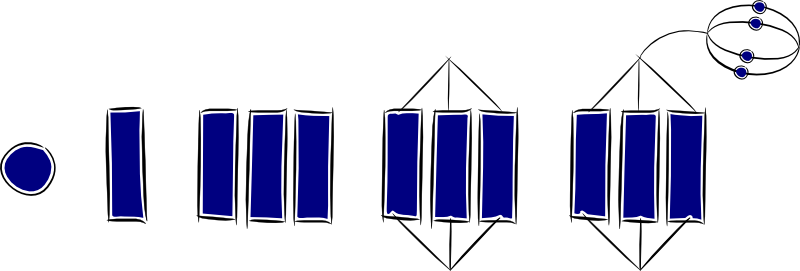SOLO Taxonomy
SOLO Taxonomy (structure of observed learning outcomes) provides a simple, reliable and robust model for three levels of understanding – surface deep and conceptual (Biggs and Collis 1982).

At the prestructural level of understanding, the task is inappropriately attacked, and the student has missed the point or needs help to start. The next two levels, unistructural and multistructural are associated with bringing in information (surface understanding). At the unistructural level, one aspect of the task is picked up, and student understanding is disconnected and limited. The jump to the multistructural level is quantitative. At the multistuctural level, several aspects of the task are known but their relationships to each other and the whole are missed. The progression to relational and extended abstract outcomes is qualitative. At the relational level, the aspects are linked and integrated, and contribute to a deeper and more coherent understanding of the whole. At the extended abstract level, the new understanding at the relational level is re-thought at another conceptual level, looked at in a new way, and used as the basis for prediction, generalisation, reflection, or creation of new understanding (Hook and Mills 2011).
HookED uses a unique classroom based approach to SOLO Taxonomy. Pam’s work has been endorsed by John Hattie (refer foreword in First Steps with SOLO Taxonomy) and John Biggs. In this approach SOLO becomes a powerful mental model for students – and is capable of changing the way they think about their own learning outcomes. With SOLO, students understand that declarative and functioning learning outcomes are the result of effort and the use of effective strategies rather than luck or fixed abilities. They are able and motivated to monitor their own progress in a learning task and to make smart decisions on their next steps. Schools using SOLO, report improvements in student learning outcomes; a raise in student confidence and increases in student engagement in learning.
This approach has been endorsed by Professor John Biggs who has been very supportive of the work and outcomes in New Zealand schools by Hooked on Thinking and more recently HookED. Refer extracts from personal communication (email) below.
” …very interesting and a new direction for SOLO as far as I know. Your slideshare presentations really delve into the application of SOLO at a level in Primary especially that we didn’t go into at all. Congratulations on your work! “
“Congratulations! I’m very pleased to see what great work you are doing in such a different context to ours. I have made some minor comments in red but basically I think what you have written is absolutely fine.”
“I have been through Slide Share and again I like it a lot. So by all means you have my permission to proceed as you see fit with that. I trust your judgement in using and interpreting SOLO.”
“Learning to learn” requires the learner to think about the strengths and weaknesses of their own thinking when they are learning and to make thoughtful decisions on what to do next. Students of all ages can use SOLO levels, rubrics and frameworks to answer the following questions:
- What am I learning?
- How is it going?
- What do I do next?
HookED uses SOLO to help students think about the strengths and weaknesses of their own thinking, to “learn to learn” and to help schools develop a common, school wide approach to making learning and learning outcomes visible to students. HookED uses SOLO to help schools develop a school-wide understanding of:
1. The learning process (SOLO and the NZC Key Competencies);
2. The language of learning used in schools. (SOLO learning verbs);
3. Learning intentions and learning outcomes (SOLO differentiated learning experiences and WALT statements);
4. Self Assessment of the learning process (SOLO differentiated student self assessment rubrics);
5. Interventions (Thinking interventions and e-learning interventions) that enhance the conditions of value when learning (SOLO differentiated interventions).
SOLO is used to:
- Plan for differentiation;
- Give and receive feedback;
- Develop self-assessment resources;
- Design innovative curriculum;
- Reflect on learning processes and products;
- Undertake research and student led inquiry;
- Integrate e-learning and thinking strategies;
- Establish a school wide common language for learning.
Refer
HookED Wiki: The advantages of SOLO Taxonomy over Bloom’s Taxonomy
Essential Resources: Introduction to SOLO Taxonomy Flyer
References:
Biggs, J. (1999). Teaching for quality learning at university. Buckingham: Buckingham Open University Press.
Biggs, J.B., & Collis, K.F. (1982). Evaluating the quality of learning: The SOLO taxonomy. New York: Academic Press.
Biggs, J., & Tang, C. (2007). Teaching for quality learning at university. What the student does (3rd Ed.). Berkshire: Society for Research into Higher Education & Open University Press.




